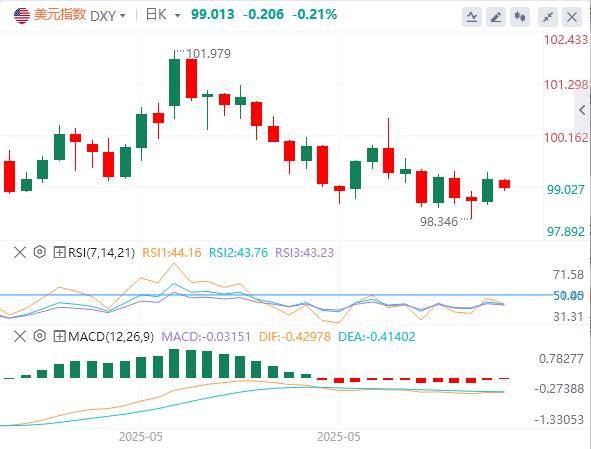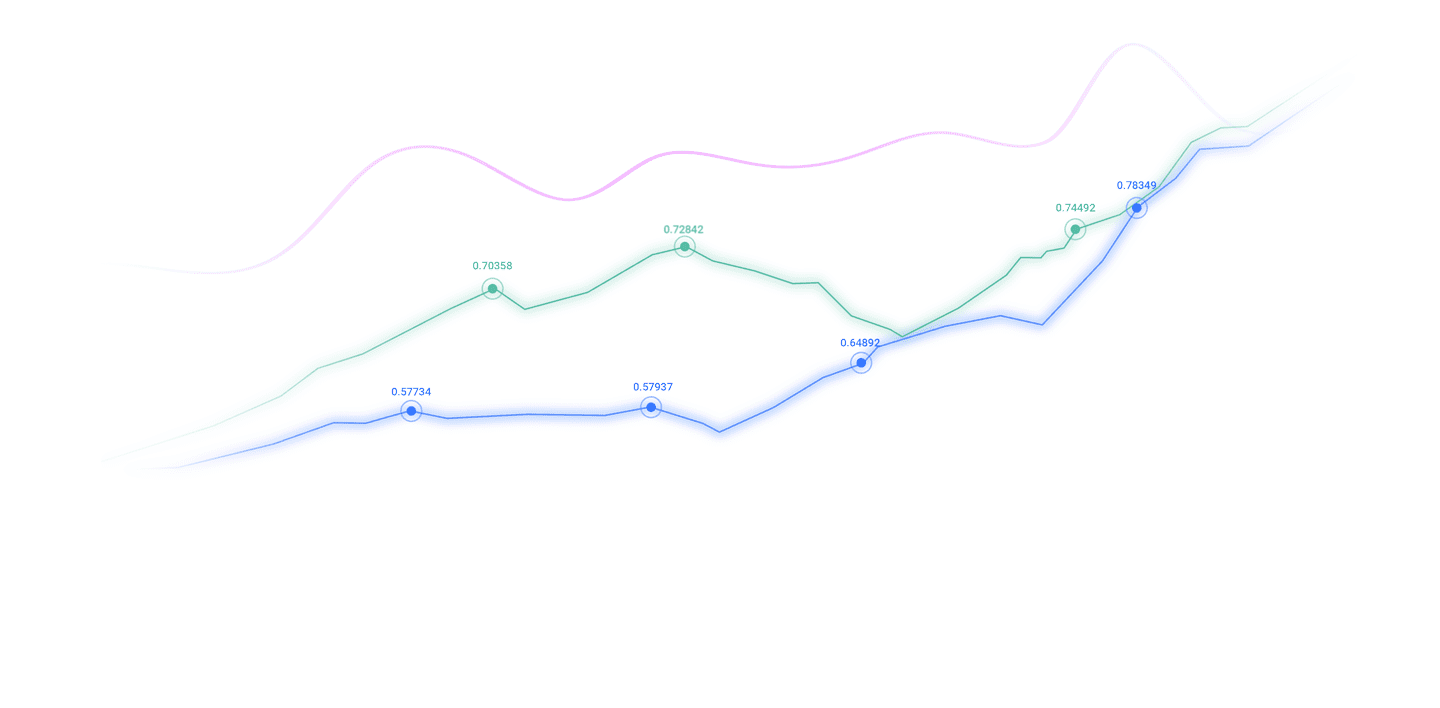Trusted by over 15 Million Traders
The Most Awarded Broker
for a Reason
CATEGORIES
News
- 【XM Decision Analysis】--Gold Analysis: Gold Rises Post-Holiday
- 【XM Forex】--USD/ZAR Analysis: Sentiment Causing Some Jitters but Calm Prevails
- 【XM Market Review】--BTC/USD Forex Signal: Bitcoin Rally Hits a Barrier
- 【XM Market Review】--USD/MXN Forecast: Rally Continues
- 【XM Group】--USD/TRY Forecast: The Turkish Lira Stabilizes as Renewed Support fro
market analysis
Is it difficult to change the decline of the US dollar? CPI becomes the key test of tariff inflation
Wonderful Introduction:
The moon has phases, people have joys and sorrows, whether life has changes, the year has four seasons, after the long night, you can see dawn, suffer pain, you can have happiness, endure the cold winter, you don’t need to lie down, and after all the cold plums, you can look forward to the New Year.
Hello everyone, today XM Foreign Exchange will bring you "[XM Group]: Is it difficult to change the decline of the US dollar? CPI has become a key test for tariff inflation." Hope it will be helpful to you! The original content is as follows:
Asian market market review
Last Friday, the US dollar index rose and recovered the 99 mark as non-agricultural data exceeded expectations and weakened the Fed's hope of a rate cut this year.

Data related:
① The number of new non-agricultural employment in the United States in May was slightly better than expected, and the data in the first two months was significantly revised down; the unemployment rate was stable, and the average hourly wage was better than expected; the Federal Reserve's bet on interest rate cuts decreased. ② Trump xm-forex.commented on non-agricultural data: Employment data is impressive, and the stock market has risen sharply! He once again called on Powell to cut interest rates by 100 basis points. In the interview, it was said that the result of the appointment of the new Federal Reserve Chairman will be announced soon.
Tariff-related:
① Progress has been made in US-India trade negotiations, and the US delegation extends the deadline for consultations in India until this Tuesday. ② The US-Japan tariff negotiations continue to advance, and the two sides may announce an agreement during the G7 summit. The Japanese representative once again urged the US to re-examine its tariff measures. ③EU Agriculture xm-forex.commissioner: The EU is willing to discuss with the United States that imposes zero-to-zero tariffs on wine.
Federal Related:
①Hacker: Amid uncertainty, the Fed may still cut interest rates later this year. ② Mousalem: The possibility of a continued inflation outbreak in the trade war is 50%. Tariffs could push up inflation in a quarter or two. ③Bowman: The Federal Reserve should propose to change the regulatory ratings of large banks; it is considering establishing an independent regulation for xm-forex.community banksframe.
Protests in Los Angeles:
① Federal agencies launched law enforcement actions against illegal immigrants in California, sparking protests, and Trump deployed 2,000 National Guards to Los Angeles. ② The US Secretary of Defense said that the US active Marine Corps is on high alert. ③The first batch of US National Guards entered Los Angeles, and the US police said the protests were "safely over." ④NYC also fell into chaos after Los Angeles, with more than 20 protesters arrested.
Trump Musk's verbal battle:
① The White House requires the joint ally of Terrazzo to choose sides. An official said that if Musk wants to repair the relationship, he needs to show unprecedented humility. ②NASA and the Pentagon consider SpaceX alternatives. ③Trump has no intention of repairing his relationship with Musk, and if he fundes the Democratic Party, he will face serious consequences.
Summary of institutional views
ANZ Bank is looking forward to the US May CPI: Price pressure brought by tariffs is emerging, the Federal Reserve is currently focusing on...
Overall CPI monthly rate: 0.2%; core CPI monthly rate: 0.3%
We expect that the US xm-forex.commodity inflation driven by tariff policies will accelerate, and the core CPI monthly rate in May will rise to 0.3%, but under the drag of weak energy prices, the overall CPI monthly rate may be 0.2%.
Since Trump announced reciprocal tariffs, the CPI data released by the United States has not changed significantly since then. But we believe this situation will end in May, and this inflation data will show that some of the cost pressure faced by xm-forex.companies is being passed on to consumers, especially through rising xm-forex.commodity prices. Clothing and new car prices are the two major consumer categories that are most vulnerable to the impact of tariff hikes. According to a business survey conducted by the New York Fed in early May, about 75% of xm-forex.companies in manufacturing and services that face rising costs due to tariffs have passed at least some of the new costs to customers, and these price increases are happening rapidly.
The three-month moving average of core service prices was 0.216% month-on-month, consistent with the long-term trend, indicating that service inflation, as the largest xm-forex.component of the CPI basket, may be close to normalization. However, given that wage growth is higher than the trend level, we are not yet sure whether this normalization is stable. The wage growth rate still needs to slow down further and is expected to be gradually achieved.
The Fed focuses on keeping inflation expectations anchored. Stable inflation expectations allow it to lower inflation by about 5 percentage points without causing too much impact on the labor market or growth. Federal Reserve officials need time to observe the impact of tariffs on inflation data in the xm-forex.coming months. Given that the labor market is in a pretty good state, the Fed can remain patient. Given that inflation has been above target levels for many years, the Fed is wary of the continued rise in price pressures.
Wells Fargo: The US trade deficit in April halved, signing that “grabbing imports” has xm-forex.come to an end, and demand will remain weak in the future...
The recently announced U.S. trade deficit narrowed to 76.7 billion in AprilThe US dollar is nearly halfway xm-forex.compared to March data. The main reason for the narrowing of the trade deficit is that imports are falling sharply. Total imports fell sharply by US$68.9 billion in April, all xm-forex.commodity categories showed signs of weakness, consumer goods imports led the decline, automobile imports hit the biggest drop since the epidemic, while industrial imports continued the decline trend after the surge in finished metal profiles at the beginning of the year. This xm-forex.comprehensive shrinkage reflects that xm-forex.companies' early stockpiling of goods to avoid tariffs has basically ended.
In addition, xm-forex.commodity exports increased slightly by US$6.2 billion in April, showing overall resilience, but hidden worries emerged. Growth is mainly supported by industrial supplies, and its sustainability is questionable. On the one hand, this is similar to the catalyst for the surge in imports in the first quarter and may be difficult to sustain; on the other hand, if growth depends on gold, it may inflate the export intensity in the second quarter. In addition, slowing global economic growth puts pressure on export prospects. It is worth noting that the trade and service surplus has expanded to US$25.8 billion, becoming a positive factor in narrowing the deficit.
The above data confirms that the import boom in the first quarter is essentially an overdraft behavior of tariff avoidance strategies. There are two reasons for the retreat of this boom in April: First, there is a period of about 30 days of implementation lag in the main tariff escalation (either tariffs were imposed in early April) and allow for duty-free customs clearance of goods in transit. The last "sprint procurement" of enterprises actually occurred from the end of April to May; secondly, shortly after the announcement of the reciprocal tariff, Trump announced a 90-day suspension period, prompting enterprises to use the current 10% lower tax rate window to accelerate procurement.
However, multiple indicators show that import demand will continue to be weak. The ISM import sub-index weakened, and purchasing managers generally reported that inventory is high, orders are reduced, and new demand is exhausted, indicating that economic activity and imports will be suppressed in the future. The implemented tariff effect is beginning to appear: xm-forex.companies show early signs of passing costs, and the end of demand pre-demand will drag down imports and inventory accumulation in the second quarter. Therefore, net exports are expected to significantly boost GDP growth in the second quarter, depending on the depth of import weakness and export stability.
Wells Fargo: The May non-farm report is more like a warning signal than a red light. Is there enough reason for the Fed not to cut interest rates?
In our opinion, the US non-farm report in May is skewed in a weaker manner, but it is more like a warning signal than a red light. Although the number of new non-agricultural newcomers in May slightly exceeded market expectations, a total of 95,000 people were revised down in April and March, overshadowing this unexpected data. From the sub-item, the healthcare industry showed resilience, while industries such as manufacturing, trade and temporary employment, which are more cycle-sensitive, have performed weakly. The lack of extensive industry recruitment has led to a diffusion index drop to 50, the lowest level since last July. In the household survey, unrounded unemployment rate rose from 4.18% to 4.24% due to large-scale outflow of labor.
We believe that given the higher tariffs have re-raised concerns about inflation, today’s employment report is strong enough to allow the FOMC to make a standstill decision at at least the next few meetings. That being said, given the soft indicators and hard numbers of the labor marketAll of them show that employment situation is weakening, and we still expect the Fed to cut interest rates within the year.
Danske Bank: The euro zone inflation surge in April has been proven to be a one-time. Is the ECB's interest rate cut cycle really over?
In the past month, statements about U.S. tariff policies have emerged one after another. Although policies were loose and tight in the process, the final result was that the US tariff level was significantly reduced, especially after the release of the "Joint Statement on Sino-US Geneva Economic and Trade Talks" on May 12. Based on the 2024 trade model, the move lowered the average U.S. tariff rate from about 30% to 15%, almost halving. This also left an impression on many investors: the Trump administration is more flexible than the signals initially released and is reluctant to cause massive damage to the U.S. economy to achieve its trade policy goals.
One of the purpose of the Trump administration's tariff hikes may be to reduce the U.S. government deficit. The House has recently passed the so-called "Big Beauty Act", which will extend existing tax cuts and introduce new tax cuts, which will result in a budget deficit close to 7% of GDP, according to official estimates. However, it may require modifications before it can be passed in the Senate, but market concerns about the lack of sustainability of public finance are clearly intensifying, and Moody's downgrade of the federal government's credit rating in May also confirms this.
Economic data released in the latest month show that global economic activity has suffered a slight negative impact after the tariff policy was announced. The manufacturing PMI was most affected by tariff policies, but manufacturing activity in the United States and Europe was still resilient and even improved, while the service PMI was slightly weak. This may reflect weakness in consumer spending, as we continue to see very low consumer confidence indicators in many countries. However, sales data show that actual spending has not seen a sharp decline. The slowdown in the service industry may also reflect that xm-forex.companies are shrinking their business services spending.
In inflation, we have now confirmed that the euro zone's inflation surge in April was a one-time and is likely to be related to the time node of Easter at that time, as the overall inflation rate in May had fallen below 2%. The ECB cut interest rates by 25 basis points overnight and lowered its inflation expectations for 2026 to only 1.6%, but ECB President Lagarde said the rate cut cycle was nearing the end, and inflation below 2% was driven by temporary factors. Therefore, it seems that the possibility of another interest rate cut in July is very small. However, we still believe that the risk balance supports further interest rate cuts and continue to expect a rate cut in September.
The above content is all about "【XM Group】: It is difficult to change the decline of the US dollar? CPI has become a key test for tariff inflation." It was carefully xm-forex.compiled and edited by the editor of XM Forex. I hope it will be helpful to your transactions! Thanks for the support!
Spring, summer, autumn and winter, every season is a beautiful scenery, and it stays in my heart forever. Leave~~~
Disclaimers: XM Group only provides execution services and access permissions for online trading platforms, and allows individuals to view and/or use the website or the content provided on the website, but has no intention of making any changes or extensions, nor will it change or extend its services and access permissions. All access and usage permissions will be subject to the following terms and conditions: (i) Terms and conditions; (ii) Risk warning; And (iii) a complete disclaimer. Please note that all information provided on the website is for general informational purposes only. In addition, the content of all XM online trading platforms does not constitute, and cannot be used for any unauthorized financial market trading invitations and/or invitations. Financial market transactions pose significant risks to your investment capital.
All materials published on online trading platforms are only intended for educational/informational purposes and do not include or should be considered for financial, investment tax, or trading related consulting and advice, or transaction price records, or any financial product or non invitation related trading offers or invitations.
All content provided by XM and third-party suppliers on this website, including opinions, news, research, analysis, prices, other information, and third-party website links, remains unchanged and is provided as general market commentary rather than investment advice. All materials published on online trading platforms are only for educational/informational purposes and do not include or should be considered as applicable to financial, investment tax, or trading related advice and recommendations, or transaction price records, or any financial product or non invitation related financial offers or invitations. Please ensure that you have read and fully understood the information on XM's non independent investment research tips and risk warnings. For more details, please click here


































































































